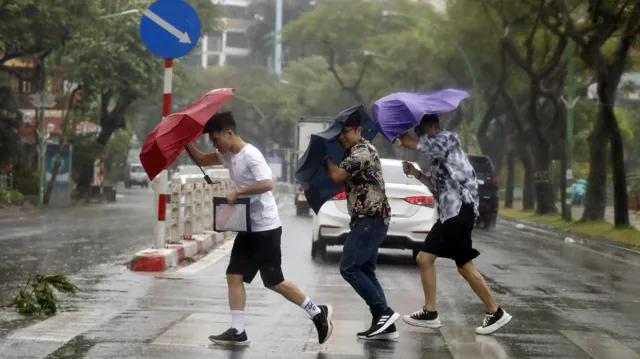
By BBC-
Super Typhoon Yagi, the most powerful storm in Asia this year, has killed at least four people after making landfall in northern Vietnam.
The storm hit Hai Phong and Quang Ninh provinces with winds of up to 203 km/h (126 mph) on Saturday morning, the Indo-Pacific Tropical Cyclone Warning Center said.
Strong winds and flying debris have caused damage to buildings and vehicles, with falling trees leading to power outages in the capital, Hanoi.
State media said three people died in the northern Quang Ninh province on Saturday, with another killed in Hai Duong, near Hanoi. Some 78 people are thought to be injured in the region.
A dozen fishermen are missing at sea.
In Hai Phong, news agency AFP reports metal roof sheets and commercial sign boards were seen flying across the city.It comes after Yagi wreaked havoc on the island of Hainan – a popular tourist destination dubbed China’s Hawaii – on Friday.
At least three people have died in China due to the storm, and nearly 100 injured.
The city of Hai Phong, on the coast of northern Vietnam, has a population of two million and has faced the brunt of the storm.

Power outages hit parts of the city – home to multinational factories – on Saturday, while four of the north’s airports have suspended operations for much of the day.
Nearly 50,000 people have been evacuated from coastal towns in Vietnam, with authorities issuing a warning to remain indoors.
Schools have been closed in 12 northern provinces, including Hanoi.
As of 20:00 local time (14:00 BST) on Saturday, Vietnam’s state meteorology agency said the storm was still producing winds of up to 102 km/h (63 mph) as it moved inland.
Satellite imagery shows the eye of the storm was south west of Hanoi by then, and is expected to move into northernmost Laos by Sunday evening.
More than 20cm of rainfall has been recorded in Hai Phong and Quang Ninh since the start of Saturday.
State media published images of motorcyclists in Hanoi sheltering under bridges to escape the heavy rain.
The storm also caused a two-storey house in the capital to collapse – though officials said it had been in the process of being demolished and so had not been inhabited.
Hanoi resident Dang Van Phuong told Reuters: “I’ve never seen such a storm like this. You can’t drive in these winds.”
On Friday, China evacuated some 400,000 people in Hainan island ahead of Yagi’s arrival. Trains, boats and flights were suspended, while schools were shut.
Local media there reported widespread power outages, with about 830,000 households affected.

Valuable crops have also been wiped out.Videos on Chinese social media show windows being ripped out from tower blocks on Hainan.
A super typhoon is equivalent to a Category 5 hurricane.
Yagi is the second strongest typhoon so far this year and has doubled in strength since it hit northern Philippines early this week.
Floods and landslides brought by Yagi killed at least 13 people in northern Philippines, with thousands of people forced to evacuate to safer ground.
Scientists say typhoons and hurricanes are becoming stronger and more frequent with climate change.
Warmer ocean waters mean storms pick up more energy, which leads to higher wind speeds.
A warmer atmosphere also holds more moisture, which can lead to more intense rainfall
